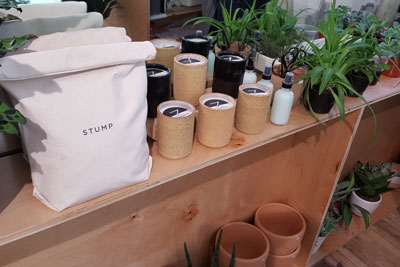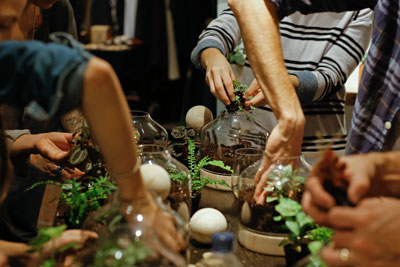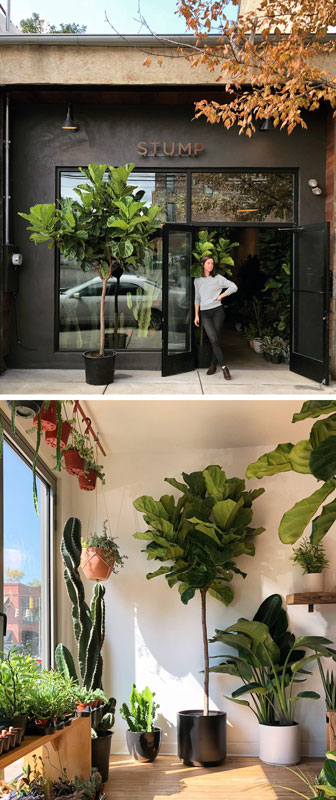12/1/2018
Trendy & Accessible
Jennifer Polanz
When STUMP came on the scene in 2015 in Columbus, Ohio, its mission was simple: sell indoor plants and educate customers of all levels of experience on how to be successful with them. What’s emerged since then—with three stores and a fourth opening in early 2019—is a diverse customer base driven by a need to be surrounded by beauty.
Owners Brian and Emily Kellett, who both graduated from the Columbus College of Art and Design before opening their first shop in Columbus’ Italian Village, were inspired by Emily’s work on the SHIFT research project with AmericanHort. Since then, they’ve expanded to a second location in German Village in Columbus and a third in Philadelphia (more on how that happened in a bit).
They’re opening a fourth location in early 2019 in a new Shaker Heights (Cleveland-area) development that’s also featuring trendy spots like celebrity chef Jonathon Sawyer’s second Greenhouse Tavern location and Mitchell’s Ice Cream (a favorite of Clevelanders).
Here’s what I learned from Brian and Emily:

1. Focus on what works best for the customer’s lifestyle.
“Our No. 1 priority and motivating force behind all of it is to keep the shop small, let customers get one-on-one attention and do what works best for you and your lifestyle,” Brian says. The educational component is vital to success and the shops feature plants, pots and only a few accessories. “We now sell fertilizer and soil in small batches,” Emily adds. “We try to make it less overwhelming.”
Even the bagged goods are trendy and stylish.
2. Work with local artists.
It’s more difficult to source products, but in the end it’s worth the effort. Emily and Brian partnered with friend and ceramic artist Dominick Frunzi to sell his pots in the stores, as well as planters from Indiana artist Rebecca Graves. They alternate through other artists monthly and also buy from a wholesale pottery company in Roseville, Ohio. All told, 90% of their hardgoods come from artists in nearby states.
Speaking of Dominick, he’s the reason for the Philadelphia location, which opened in July. He’s an artist there and they joked about opening a Philly shop until it became a reality this year.

3. Unisex designs allows for an all-inclusive store.
As I mentioned in my story on more men shopping garden retail (page 24), Brian notes that the unisex design of their stores makes men feel more comfortable shopping. But it’s not just men. “Surprisingly, our shoppers are much more diverse than you would imagine,” Brian says. “On Instagram, the majority of our followers are Millennials, but in the shop it ranges from high school and middle school kids to 70-plus-year olds of all different backgrounds and races. Age-wise it’s the full gamut.”
Events like this terrarium one attracts enthusiasts of all types.
4. Social media is driving houseplant sales.
For better or for worse, social media sites like Instagram and Pinterest are driving the houseplant trend. Why worse? Because sometimes the plants that are trending, particularly from photos taken outside the country, aren’t widely available here. “There’s a gap in what people are growing versus what people want,” Emily says. “They want the more rare, hard-to-find houseplants.”
She used variegated monstera as an example of a plant that was in high demand but was difficult to source. “It was blowing up on Instagram, but the photos were from Europe,” she adds. “It was $100 for a tiny plant. Now you can find them for a reasonable price because demand grew.”
The other problem with social media is it often doesn’t represent where plants will survive. “Where we come in is teaching people that the photo you saw on Pinterest doesn’t actually work in real life,” Brian says. “If you put that olive tree in the corner like that it’s going to die and you’re going to cry. We have to find a balance between looking good and where it lives.”

5. Looks matter—everywhere.
It’s no surprise the STUMP website, social media sites and stores all look trendy and beautiful—Brian and Emily have art degrees and backgrounds in photography and design. Brian also has experience in furniture design and creation, so a lot of the displays in the stores are his work. In this day and age, it’s vital that everything involved in a brand looks cohesive, uniform and stylish. It’s also authentic, since both Brian and Emily are Millennials who love houseplants themselves.
“It made it easier for us to come in at the time we did and approach it in a way that’s natural for us. We’re living that lifestyle where houseplants are relevant,” Emily says, adding the art degrees helped immensely. “The easy thing for us is super hard for others—the design and aesthetics. That’s what we’ve been doing since we were in high school.” GP
The exterior and interior of the German Village location.